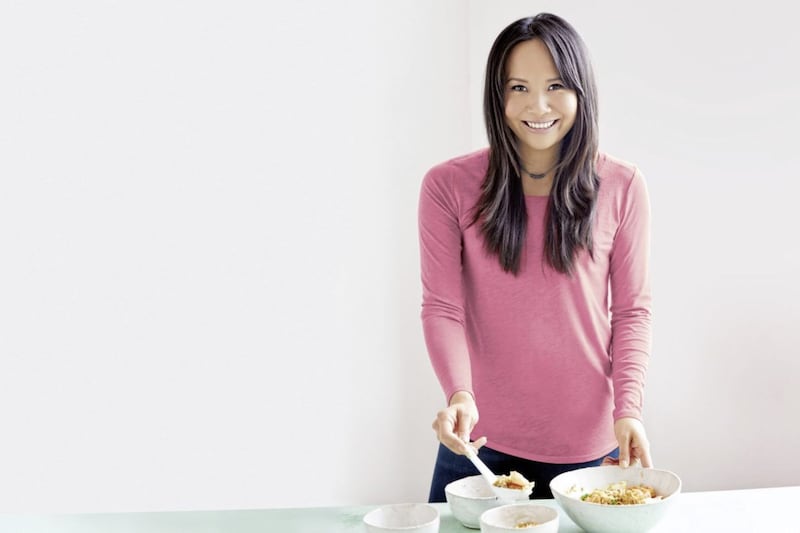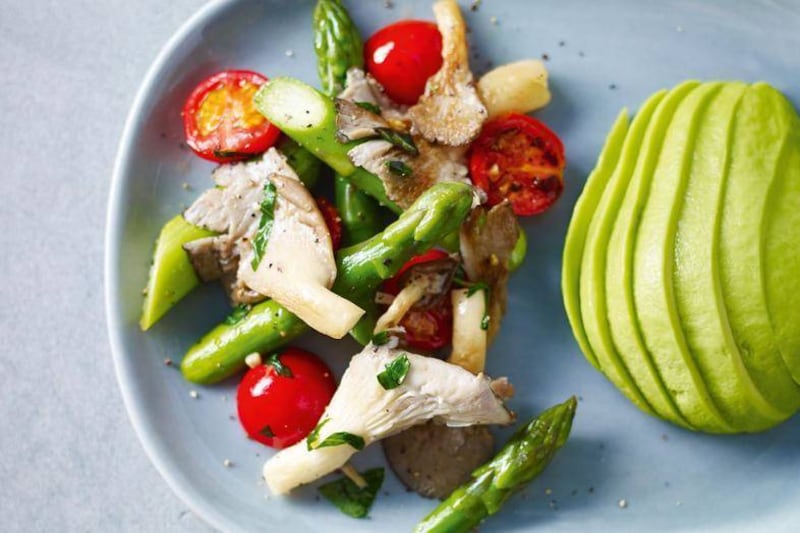CHING He Huang switched to plant-based eating after seeing how it could dramatically change people’s lives.
Her husband, Jamie Cho, started Huang on a “journey of self discovery”, the 42-year-old chef and presenter says. explains. Within a month of trying it himself, Cho noticed improvements in his asthma, eczema and psoriasis.
Of course, everyone’s body is different and may react differently – it’s worth checking with a medical professional if you’re considering big diet changes, especially if you have existing health conditions – but for them, Huang says it was “quite a revelation”.
It encouraged her to experiment with plant-based foods, which initially felt at odds with her background. “Being a Chinese chef, we experiment, and being a Chinese food connoisseur you’ve got to try everything,” she confesses.
However, Huang did find plant-based eating aligned well with the Chinese philosophies she’d been brought up on by her family in southern Taiwan.
“I’ve always believed in ‘you are what you eat’, [and in] a balanced diet,” she explains. “I grew up with my parents and my grandparents, and they eat seasonally.
“Think about yin and yang; balancing hot and cooling foods depending on your body, a little bit like the Indian Ayurvedic principle of eating. If you’re tired and stressed, your body’s very yang – if you’re always cold and shivery, then your body’s too yin, you’re having too many yang and fiery foods.”
So how do you balance this yin and yang? Firstly, Huang says: “You literally just need to listen to your gut” – then you’ll be able to properly judge what your body needs. She remembers her grandmother saying if “you eat too many vegetables, you need to have ginger because vegetables are yin and ginger is very yang – it’s fiery, so it balances your body. On a vegan diet, you need to have more garlic, ginger, chillies – more yang dishes,” she explains. “Mostly, yang ingredients are from meat.”
How you cook your meals also plays a part. “Steaming is more yin and stir-frying is more yang,” says Huang. “Overall, we’re trying to create the perfect balance. I think it’s really hard in the modern day to try and create this balance – to even understand it – but I think food is a conduit to that.
“We could be bombarded with all this technology and science, but you actually have to listen to our instincts.”
For Huang, it made sense to adopt a plant-based diet, saying it “aligns with who I am” – and the results make it worth it. Asked how she feels, she says: “Much healthier and lighter, I just have more energy – but obviously everyone should do what’s right for them”.
The chef doesn’t just think about the personal reasons for going plant-based, but the bigger picture as well. She says: “If we look at ourselves as an entity, then look at ourselves in a greater picture, in a way it is a reflection of what we’ve done to this planet – the way we pollute the planet and the way we over-consume.
“Everything is about balance, so if we’re out of balance, then we’re going to be ill. The same thing; if we over-pollute the planet, it’s not going to create the best environment for us.”
Huang’s personal journey led her to write Asian Green. It might be Huang’s first fully vegan cookbook but it’s her 10th overall, and stays true to her food ethos of getting “maximum flavour with minimum fuss”.
Her recipes are democratic, she says. “Not all of us are from the same background, but we all love food and we want it to be a simple process. If you cook something and it works and you feel happy and satisfied about it, then you’re more likely to cook again.
“Once people cook, it’s a way to express love, because you’re taking care of yourself. And once you learn how to cook and you’re confident, then you know how to cook for somebody else.”
For Huang, this is the ultimate way to show you care, and “if you choose to cook compassionately, then you’re looking after the greater and you’re extending your love to everything else”.
Huang might look at things very philosophically but she does so with a light touch – and without any judgment. She just wants to encourage people to “try it for yourself”. If you’re thinking about a vegan diet, Huang recommends doing so with a group of friends, “so you’re not alone”.
She says simply: “Whether it’s for animals, or your health, or you just want to try something new, I think people should celebrate more veg.”
:: Asian Green: Everyday Plant-based Recipes Inspired By The East by Ching-He Huang, photography by Tamin Jones, is published by Kyle Books on February 11, priced £20. Below are two recipes from the book for you to try.
VEGAN STIRY-FRY WITH BLACK BEAN TOFU AND BABY PAK CHOI
(Serves four as a side)
1tbsp cornflour
1tbsp rapeseed oil
5 garlic cloves, finely chopped
1tbsp freshly grated root ginger
1 red chilli, deseeded and chopped
1 bird’s eye chilli, deseeded and chopped
1tbsp fermented salted black beans, rinsed and crushed
1tbsp yellow bean paste or miso paste
250g ready-fried tofu, quartered
1tbsp Shaohsing rice wine or dry sherry
2 green peppers, deseeded and cut into 1.5cm chunks
200ml vegetable stock
1tbsp tamari or low-sodium light soy sauce
Cooked jasmine rice, to serve
For the pak choi:
200g baby pak choi, halved
Pinch of sea salt
1tbsp Shaohsing rice wine
1tbsp tamari or low-sodium light soy sauce
1tsp toasted sesame oil
2.5cm piece of fresh root ginger, sliced into matchsticks
Method:
First, prepare the pak choi. Place a heatproof plate inside a bamboo steamer. Season the pak choi with salt, rice wine, tamari or light soy sauce and toasted sesame oil, then lay the ginger slices over the top. Place the lid on the steamer and set over a wok or pan of water. Bring to the boil, then gently steam over a low heat for three to four minutes.
In a small jug or cup, mix the cornflour with two tablespoons of water to create a slurry and set aside until needed. Meanwhile, place a wok over a high heat and add the rapeseed oil. When the oil starts to smoke, add the garlic, ginger and chillies and stir-fry for a few seconds. Then add the black beans and yellow bean paste and stir quickly.
Add the tofu and stir-fry for one minute, keeping the ingredients moving in the wok, then add the rice wine or sherry and the green peppers and stir-fry for a further minute.
Add the stock and bring to the boil. Season with the tamari or soy sauce, then add the cornflour slurry and stir to thicken.
Serve the black bean tofu and steamed baby pak choi with jasmine rice on the side and eat immediately.
SMOKED TOFU AND BROCCOLI KOREAN-STYLE VEGAN RAM-DON
(Serves four)
200g dried ramen or udon noodles
1tbsp toasted sesame oil
2 garlic cloves
2.5cm piece of fresh root ginger, peeled
3 shallots
2 red chillies, deseeded
1tbsp cornflour
1tbsp rapeseed oil
200g smoked tofu, drained, rinsed in cold water and sliced into 2cm cubes
400g firm tofu, drained and sliced into 2cm cubes
200g fresh shiitake mushrooms
1tbsp Shaohsing rice wine
2tbsp dark soy sauce
150g long-stem broccoli, florets sliced lengthwise and stalks sliced into 0.5cm rounds
2tbsp vegetarian mushroom sauce
1tbsp clear rice vinegar
1tbsp tamari or low-sodium light soy sauce
2 spring onions, trimmed and finely sliced on the angle into 1cm slices
Noodle seasoning (per bowl):
1tsp dark soy sauce and Chiu Chow chilli oil
1tbsp each tahini and sweet chilli sauce
Sprinkle of shichimi togarashi pepper flakes
Method:
Cook the noodles according to the packet instructions. Rinse under cold water and drain well, then drizzle over the toasted sesame oil to prevent them from sticking together. Set aside in the colander until needed.
Place the garlic, ginger, shallots and red chillies in a small food processor and blitz to form a paste. Mix the cornflour with two tablespoons water in a small bowl or cup to make a slurry. Set aside until needed. Heat a wok over a high heat until smoking and add the rapeseed oil. Once hot, add the aromatic paste and cook, stirring, for a few seconds until fragrant. Add both kinds of tofu and the mushrooms. Season with the rice wine and dark soy sauce and toss together well for one to two minutes until all the ingredients are coated.
Add the broccoli and cook, tossing, for one minute. Stir in the mushroom sauce, rice vinegar and tamari or light soy sauce. Pour in the cornflour slurry to thicken the cooking juices in the wok, and toss to mix well.
Pour some boiling water over the noodles in the colander to reheat them, then divide them between four bowls.
Place a ladleful of the tofu, mushroom and broccoli mixture on one side of the noodles in each bowl, and top with the sliced spring onion. Dress the noodles by drizzling over the dark soy sauce, Chiu Chow chilli oil, tahini and sweet chilli sauce, followed by a generous sprinkle of shichimi togarashi pepper flakes. Serve immediately.







